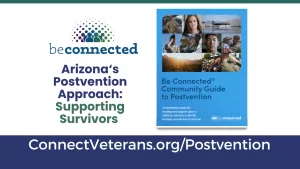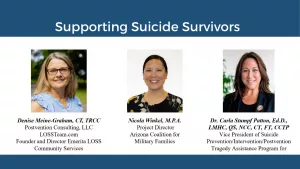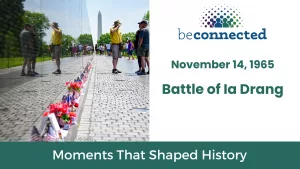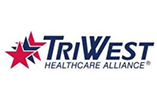Helping People After Suicide Loss
Foreword
Recently, Nicola Winkel, MPA, Project Director for the Arizona Coalition for Military Families, joined two national leaders in postvention, Denise Meine-Graham and Dr. Carla Stumpf Patton, for a powerful discussion on what it truly means to support people after a suicide loss.
The session focused on healing, coordinated response, and the often overlooked reality that suicide loss survivors face an increased risk themselves. It also marked the first webinar in a new learning series dedicated entirely to postvention: how it works, why it matters, and how communities can strengthen their capacity to respond with care.
Nicola shared how Arizona has been working on two major efforts at the same time, developing a veteran-specific suicide mortality review process and expanding postvention resources statewide. Both efforts have shaped Arizona’s understanding of what survivors need immediately after a loss and in the months that follow. And both reinforce a central point: postvention is not separate from prevention. It is a critical part of it.
The conversation also highlighted why Arizona’s work, including the creation of the Be Connected Community Guide to Postvention, has become such an important part of the state’s story and a growing model for others.
A Community-Centered Approach
Supporting survivors of suicide loss is some of the most important work in suicide prevention. During the recent webinar Support After Suicide Loss: Postvention for Service Members, Veterans, and their Families, three national leaders in the field explored what communities can do to help people in the days, weeks, and months after a suicide. Denise Meine-Graham, Dr. Carla Stumpf Patton, and the Arizona Coalition for Military Families’ own Nicola Winkel shared their experiences, research, and practical insights. Together, they made one central point unmissable: postvention is not separate from prevention. It is a critical part of it.
The Ripple Effect of Suicide Loss
One of the most important parts of the conversation was the reminder that suicide loss affects far more people than most of us realize. Research presented by Dr. Julie Cerel shows that an estimated 135 people are touched by every suicide. This includes immediate family, but also battle buddies, peers, supervisors, classmates, neighbors, and people who may not be publicly recognized but are deeply impacted. Denise Meine-Graham described four groups affected by suicide:
- those who are exposed
- those who are affected
- those who experience short-term bereavement, and
- those who experience long-term bereavement.
Each group experiences the loss differently, but all require care and awareness.
Arizona’s own data underscores this reality. Through the work of the Arizona Veteran Suicide Mortality Review Team, a significant finding emerged: 25 percent of the veteran suicide cases reviewed had a family history of suicide. This insight reinforces something communities often feel but might not talk about – that suicide loss can affect multiple generations, and without early, coordinated support, the risk of further suicide losses can grow, rather than diminish over time.
Vulnerabilities After Suicide Loss
Surviving a suicide loss brings an elevated risk of suicide for the people affected. The reasons are both emotional and practical:
- the trauma of the loss itself
- self-blame, guilt, or shame
- isolation or withdrawal
- the sudden collapse of a sense of safety or predictability
- pressure to “be okay” before they actually are
Early, Compassionate Support Saves Lives
This elevated risk is why early postvention is key. Postvention after a suicide is a method to prevent future suicide losses. When communities build a coordinated approach to postvention, they reduce isolation, increase safety, and make it more likely that survivors will reach out or accept support. And when one in four reviewed cases carries a family history of suicide, the importance of early support becomes even clearer. Postvention is not just a compassionate response. It is a protective factor.
A Practical Guide for Postvention
The Be Connected Community Guide to Postvention provides clear, evidence-informed strategies to support survivors. Inside the guide you’ll find:
- What postvention is and why it matters
- How suicide loss affects communities
- The difference between comfort and support
- How to reduce stigma and shame
- Examples of affirming, supportive language
- Tips and self-care information
What Communities and Organizations Can Do Right Now
- Build clear postvention protocols: Having a plan that outlines roles, communication, next steps, and shared messaging prevents confusion and ensures the community responds with care instead of scrambling.
- Train staff, volunteers, and partners: Having trained helpers embedded within the community is a way that suicide loss survivors can benefit from a shared understanding of postvention and trauma-informed practices.
- Integrate postvention into upstream suicide prevention planning: Arizona’s experience shows that suicide prevention is stronger when postvention is included. This alignment keeps communities prepared to respond when a loss occurs and helps insulate against further losses.
Postvention as Prevention
Arizona is building its postvention work through two major efforts:
- The Veteran Suicide Mortality Review Team, which helps partners understand the factors surrounding each loss
- The expansion of statewide postvention resources, including the Be Connected Community Guide to Postvention
These efforts inform each other. The mortality review team’s findings strengthened Arizona’s commitment to making postvention a foundational part of suicide prevention. This approach recognizes a simple truth: when survivors receive early, trauma-informed support, communities reduce future suicide risk.
When we recognize how widely and deeply suicide loss reverberates, and how risk can repeat across families and generations, our responsibility becomes unmistakable:
show up early, show up gently, and show up together.
Strengthening How We Respond
Understanding how far suicide loss reaches, and how risk can repeat across families and generations, makes one thing clear: postvention must be part of every prevention strategy. Arizona’s approach reflects that reality. By understanding the losses so we can equip partners with practical tools and ensure coordinated support for survivors, we are strengthening the systems that keep our communities safe. This steady, informed response is how Arizona continues advancing upstream suicide prevention in a meaningful way.
Support After Suicide Loss: Postvention for Service Members, Veterans, and their Families
How can communities respond after a suicide loss? This SAMHSA SMVF TA Center webinar, held November 4, 2025, offers guidance and tools to support Service members, Veterans, and their Families.
Support Resources
The Arizona Coalition for Military Families and the Be Connected program offer connection to resources for people, families, organizations, and communities affected by the suicide of a service member or veteran.
- For life-threatening emergencies, call 9-8-8, which is a 24/7 crisis line. Press 1 for veteran-specific support services.
- For connection to support resources, call the Be Connected Support Line at 866-4AZ-VETS (866-429-8387) Monday – Friday, 8 a.m. to 5 p.m. MT.
- For a personalized plan, complete this form, and our Postvention team will reach out.
- Download a free digital copy of the Be Connected Community Guide to Postvention.
- Request print copies of the Be Connected Community Guide to Postvention to share at ConnectVeterans.org/Order
- Get answers to the most frequently asked questions about our no-cost postvention support at ConnectVeterans.org/Postvention.
- Reach our trained team directly at prevention@arizonacoalition.org.
- Consider attending a no-cost workshop or bringing our workshop to your location.









